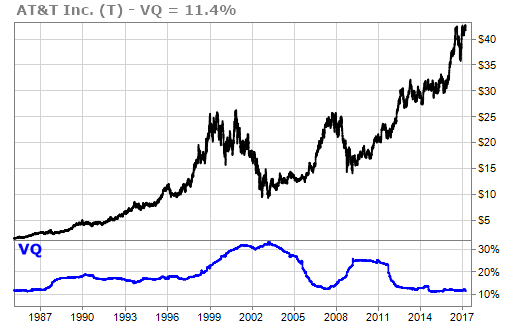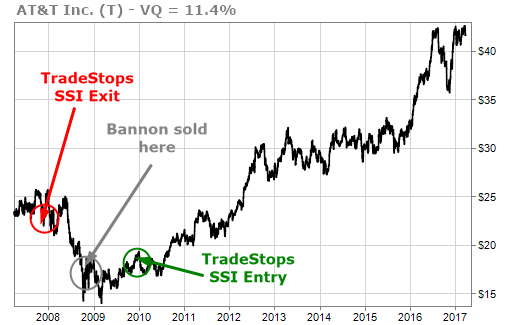We looked at how a panicked investment decision helped propel Donald Trump to the most powerful position in the world. Today we’re going to show you exactly how that mistake was made … and what you can do to avoid making the biggest investment mistakes of your life.
To briefly recap, Steve Bannon’s father, Marty Bannon, sold all his AT&T stock (NYSE: T) in a panic near the bottom of the 2008 – 2009 market crash. The ensuing loss that his father experienced convinced Steve Bannon that there was a war to be fought against the “elites” and on behalf of hard-working middle class families like his father’s. Then Steve Bannon met Donald Trump and the rest, as they say, is history.
AT&T was supposed to be the Bannon family’s insurance policy against financial disaster. The company had been there for the Bannon family for decades, employing both Marty Bannon and even Marty’s father (Steve Bannon’s grandfather).
The trouble was the AT&T stock that Marty Bannon owned in 2008 was not the same AT&T to which both Marty and his father had both given decades of their professional lives. Marty Bannon fell victim to a very common emotional bias – anchoring – and it proved to be his undoing.
Marty Bannon was “anchored” to the old AT&T … and that anchoring blinded him to the reality of what AT&T actually was in 2008.
At the time that Marty Bannon began working for them, AT&T was known as the “stock for widows and orphans”. It was a utility stock, not much different than an electric company. It was a monopoly that was regulated by the authorities. Slow growth and good dividends were the hallmark of the stock.
That changed 35 years ago when AT&T was broken up into the “Baby Bells”. Suddenly, the landscape changed and T was not the same company that Marty Bannon believed it to be. The internet was developing and new opportunities in wireless communications were available to T and all the telecom companies. The slow-growth company that characterized T over many decades was no longer the reality.
AT&T had changed, but Marty Bannon’s perception had not changed.
The chart below shows the price history of AT&T over the last 30 years. This is AT&T after the breakup of the original monopoly. The blue line in the bottom of the chart is a chart of the historical VQ, our Volatility Quotient indicator.

The TradeStops VQ is an indicator of how volatile or “noisy” a stock is. It tells you how much you should expect a stock to move up or down over the course of 12 to 18 months just due to uncertainty about the future of the investment.
You can see in the chart above that the VQ on AT&T steadily rose after deregulation from a low of around 10% to a high of about 32% in 2003. For purposes of comparison, Tesla currently has a VQ of 30% today.
We guarantee you that Marty Bannon was not thinking of AT&T the way that most investors think about Tesla today.
At TradeStops, we consider stocks with a VQ of greater than 30% to be high-risk stocks. So, for much of the time he owned it, Marty Bannon’s assumption that T was a “safe” stock was incorrect. He was anchored to his earlier view of the company.
In 2008, the stock’s volatility increased as the financial crisis deepened. All the news was bad and the media was making things worse. Bannon was undoubtedly regretting owning his position in T as the stock price was collapsing. Finally, he hit his tipping point and made the emotional decision to sell T. Unfortunately, he sold at almost the absolute bottom of the stock.
Had Bannon been using TradeStops, this would have been an easy decision. He would have exited his position in November, 2007 at a much higher price and would have been able to get back in when the Stock State Indicator (SSI) Entry signal was triggered in December, 2009.

Bannon thought he was invested in a safe stock, yet by the 2000’s, AT&T was a lot riskier than he thought. That disconnect between his ideas about AT&T and the reality of AT&T made him much more vulnerable to making an emotional investment decision that he would almost certainly regret.
We haven’t had a stock market crash in almost a decade, but it will happen again. Nobody knows when. And the media will be doing their best to scare you into making bad decisions. If you don’t want outsiders to control your investment future, then your best bet is to make sure that your expectations of your investments are in line with the reality of today’s markets.
To aligned expectations,
TradeSmith Team





